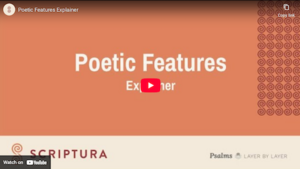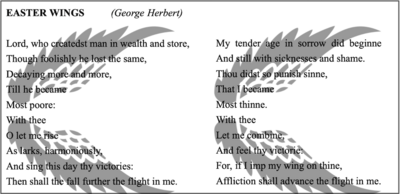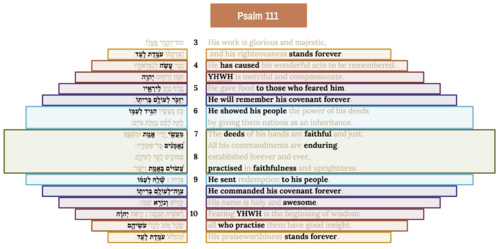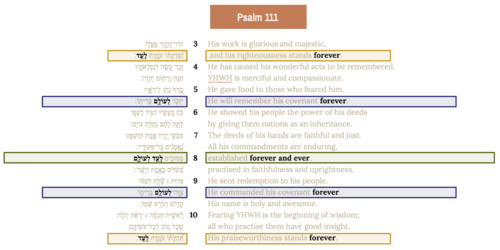Users Guide: Poetic Features
Warning: Display title "Users Guide: Poetic Features" overrides earlier display title "User's Guide/Poetic Features".
User's Guide Contents
Poetic Features
In our poetic features layer we explore the beauty and artistry of each psalm, and how the poetic design of the psalm shapes and reflects its message.
Painting with Words
The psalmists, like all great poets, were painting with words. In other words, they didn’t just write their message in plain words, but like painters they used language to create patterns and images that bring the message to life.
Compare, for example, "Easter Wings" by George Herbert. The poem uses the image of wings, flight, and rising from suffering—but Herbert didn’t just say that. He painted it - shaping the words themselves into two sets of wings.
Now consider how the author of Psalm 111 was also painting with words. This psalm celebrates God’s deeds, and each line begins with the next letter of the Hebrew alphabet—an acrostic pattern.
Then from verse 3 onward, it also follows a chiastic structure—a symmetrical design where the outer lines match, then the next inner lines between these match, forming six mirrored pairs around the center in verses 7–8.
And if that wasn’t intricate enough, the psalmist adds even another symmetrical pattern using words for time. The word לָעַד (forever) appears at the beginning and at the end, then לְעוֹלָם (another word for forever) and לְעוֹלָם matching between these, and then לָעַד and לְעוֹלָם combined together in the middle in v. 8.
Poetic Features Defined
These design patterns in the psalm are poetic features. Poetic features can be defined as follows:
A poetic feature is:
any element of intentional design built into a text
to shape and reflect the meaning of that text.
There are three key ideas within this definition: (1) Poetic Feature, (2) Poetic Devices, and (3) Poetic Effect.
The (1) feature is the actual concrete element of intentional design built into the text. These are usually created using (2) poetic devices. So in the case of Easter wings the specific, concrete feature is the wing shape of the words, and the poetic device, generally, is the technique of word-shaping (aka shape poetry).
There are many poetic devices used to create poetic features, and many features combine multiple devices, or even innovate new devices. Some of the most common devices include:
- Structural Devices:I.e., features that create structural patterns in the text. Repetition, inclusios, acrostics, numerical patterns, repeated roots, among others…
- Sound Devices:I.e., features that use sound patterns. Rhyme, alliteration, wordplay, assonance, among others…
- Layering Devices:I.e., features that create an added layer of meaning to the words. For example, an allusion to a text from Genesis in Psalm 19 adds a whole new layer of meaning to the basic level of meaning as the words appear in Psalm 19. Allusion, metaphor, simile, personification, symbolism, among others…
Once we have a clear view of the feature, the element of intentional design, and the poetic device or devices used, we are ready to show the effect. (3) The effect is the way that this feature shapes and reflects the meaning of the text.
So in the case of Easter Wings, the wing pattern clearly reflects the central theme of wings, flight, and rising out of suffering, and brings that message into special focus. For Psalm 111 the alphabet pattern for example gives a sense of completion, as if to say it’s a complete, aleph to tav, a to zed celebration of God’s deeds. For a complete presentation of the poetic features in Psalm 111 and their effects, see here .
Resources
For each psalm we select the top three poetic features and create a visual presentation of them, arranged across three tabs. A fourth tab is also included with a presentation of all repeated roots in the psalm.
Take for example the poetic features of Psalm 19 . Each poetic feature has a visual layout of the text which highlights the feature, and an explanation of the feature (the element(s) of intentional design built into the text), and an explanation of the effect (the way the feature shapes or reflects the meaning of the psalm).
- The first feature in Psalm 19 is about the combined imagery of the Sun and the Torah.
- The second feature is an intentional numerical design with 7 occurrences the name of YHWH.
- The third feature examines intentional allusions to Genesis, showing how the whole psalm uses words echoing Genesis chapters 1-4, from God’s creation of the heavens, his commandment not to eat from the tree, through to Cain’s struggle not to be overcome by sin.
Criteria for Evaluating Poetic Features
When we create our poetic feature layer, we evaluate each feature according to three criteria:
- Significance: How significant is the poetic feature in its contribution to the message/progression/power of the psalm as a whole? Or is its significance not clear or limited to only a small section? Or merely structural (e.g. marking off section/stanza breaks)?
- Intentionality: With how much confidence can we say that the feature is part of the intentional design of the psalm? What compelling evidence points to intelligent design behind the feature? What poetic techniques are being used to create the feature?
- Clarity: Is the feature clear, coherent, and simple enough to grasp quickly? Or is does it feel convoluted, with too many elements, unintegrated elements, or too many possible effects? How effective, elegant, and clear are the visual presentation and the feature/effect boxes?




